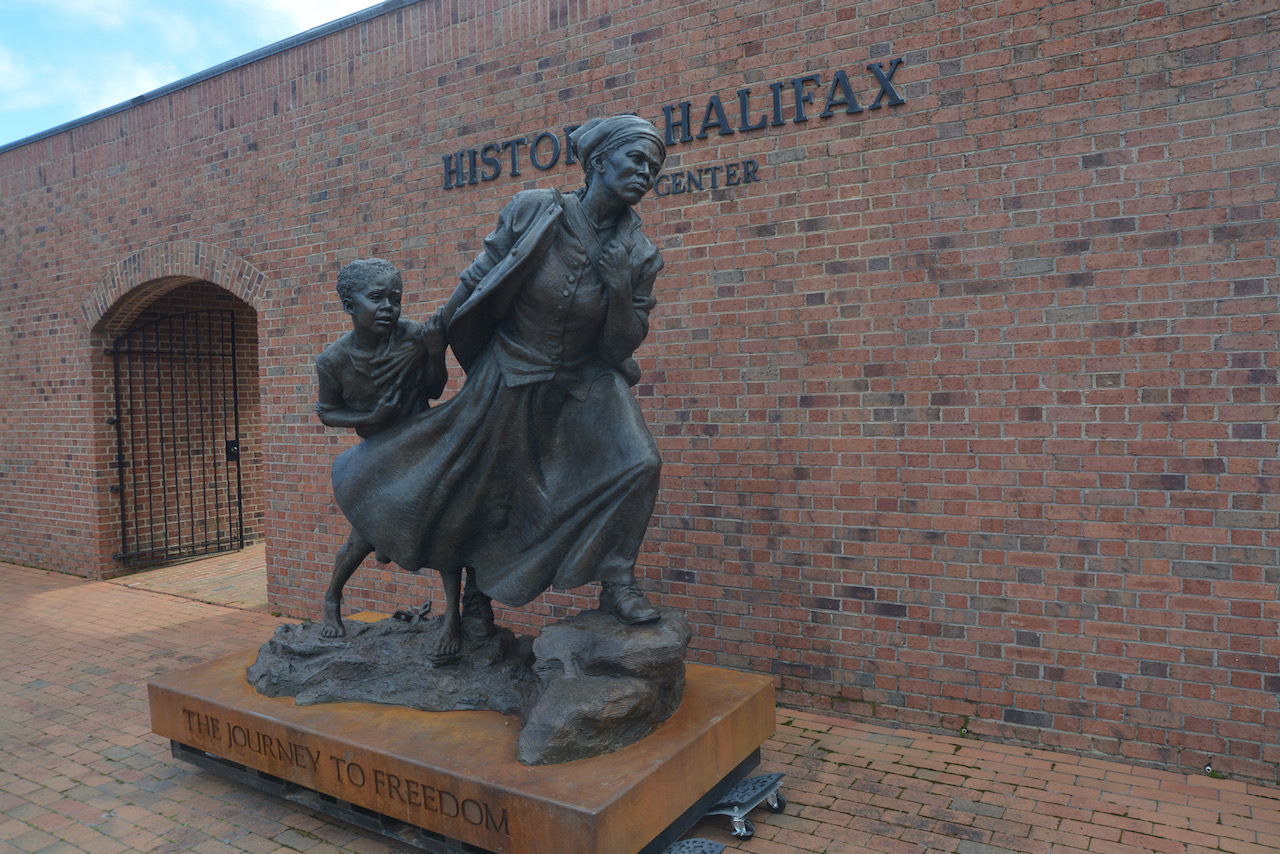Beginning Wednesday, Historic Halifax, in conjunction with the Halifax Underground Railroad will present the Harriet Tubman — Journey to Freedom Exhibit.
It will feature for the first time in North Carolina the replica statue created by Cashiers artist Wesley Wofford of Tubman leading a young girl to freedom.
The exhibit will be on display outside the visitors center on St. David Street in Halifax through April 18 and on Friday a virtual event which can be viewed on the Underground Railroad Facebook page will be held from 2 p.m. to 3 p.m.
“I’m standing here and there are chills in my body and tears in my eyes,” said Gary R. Grant as he looked at the statue after it was unloaded from a flatbed.
Grant serves as president of the board of Halifax Underground Railroad. “It’s a reminder that we need to honor Black History not for one month but every day of every month.”
The exhibit coincides with the end of Black History Month in February and the start of Women’s History Month throughout this month. It comes to a close six days after Halifax Resolves Day — April 12.
The sculpture
The original sculpture by Wofford is in a private building in Dallas.
A synopsis of the creation calls it the artist’s most significant monument to date. “Harriet personifies a role model and hero, and we are proud to commemorate the resilience and contributions of strong women throughout history.”
In describing the sculpture, the synopsis reads, “Harriet is confidently leading a slave girl on the Underground Railroad to freedom. She is leaning into the wind with her shoulder, chin down, and bracing herself against the elements.
“Her eyes are cut formidably up, anticipating the next part of the journey. The wind illustrates the peril of the journey but is also a metaphor for the intense opposition she faced.”
Tubman’s dress protectively envelops the girl, billowing like a flag. “This represents all of the legal protections afforded to every United States citizen — a symbol of the future equality to come.”
The contours of the base are the Maryland-Delaware Peninsula where Tubman was enslaved, eventually escaped, and continued to return for her freedom raids. “The dramatic step up/cut is the Pennsylvania state line and the two are stepping out of the slave states to an elevated freedom.”
Then there is the description of the hands which represent determination, protection, fear and trust. “The slave girl is leaning out to get a better look at where Harriet is taking her with a look of trepidation on her face. The girl is gripping Harriet's right arm tightly but her delicate finger grasp is cautiously hopeful.”
The girl is off balance and tentatively taking a step forward — her left foot precariously hanging off a cliff, illustrating the danger and peril of the journey. “The shackles are broken and the atrocities of slavery are left forever behind.”
Sandra Bryant served on the steering committee with Historic Site Manager Carl Burke, Steven Green — treasurer of the Halifax Underground Railroad non-profit — and Lori Medlin of the Halifax Convention and Visitors Bureau.
“I think it’s absolutely amazing,” Bryant said of the statue. “Harriet Tubman leading people to a new home. It gives me chills. She never lost a passenger. She started with the Union Army as a cook and had been a spy.”
What the statue signifies to Bryant is that Tubman was getting closer to bringing freedom to the child.
The program
The exhibit comes as Halifax County has received three designations from the National Parks Service as a National Underground Railroad Network to Freedom site.
One of the trails is located at the Historic Site, the second is at River Falls Park and the third is located at the Roanoke Canal Museum and Trail.
For the program Friday, in which only 50 people are allowed in accordance with the state’s COVID-19 guidelines, the following will participants:
Wofford the sculptor
Michelle Lanier — director of the state’s historic sites
Halifax County Manager Tony Brown who will deliver a resolution from the county
Earl Ijames — curator of African American history at the North Carolina Museum of History
Jackier Ruffin-Pittman, who portrays Piety, who served as a cook for the Roanoke Navigation and made a living until she was recaptured
Bryant said sponsors for the virtual event Friday include her brother Kerr Putney of KMP Global Consulting and Medlin of the HCVB.
“We’re happy to be the first in North Carolina to display the statue,” Burke said. “We hope people will come to see it and visit all the sites.”
Green said the program has been in the works for the last 16 months. “The artist is from North Carolina and wanted to present the statue here. “We’re so excited it’s going to be making it’s North Carolina debut in Halifax. The statue has won numerous awards and has been featured in a worldwide sculpture magazine. We’re just happy to see this day arrive.”
Those wishing to make a donation to Halifax Underground Railroad non-profit may do so by downloading a form at this link






